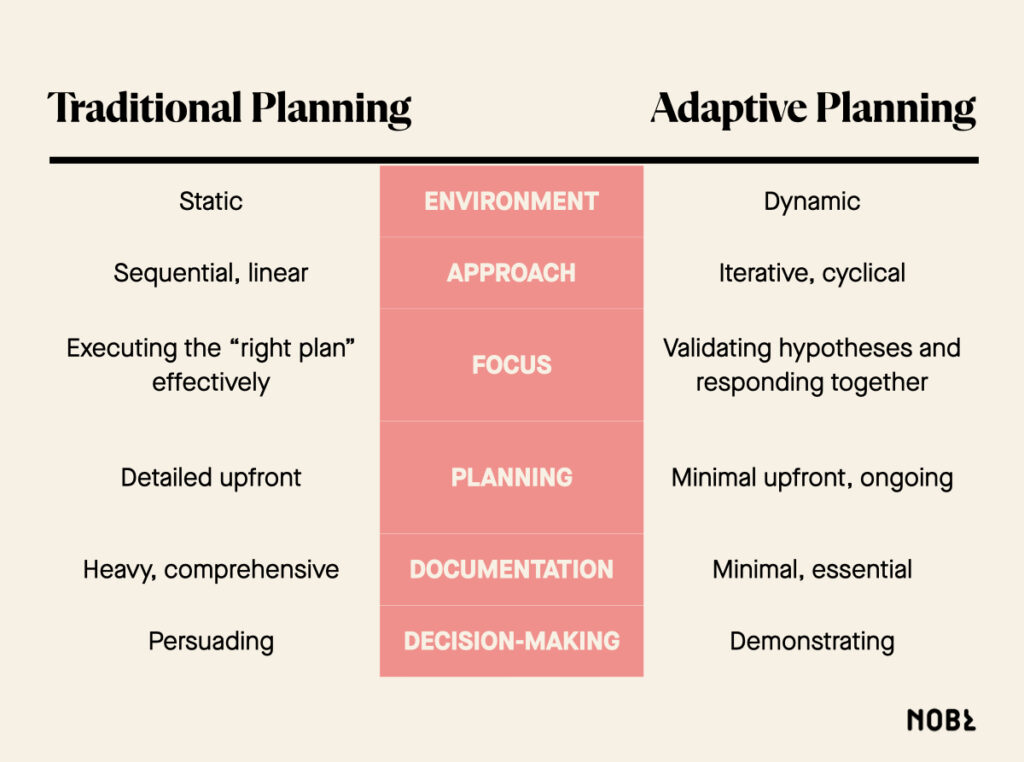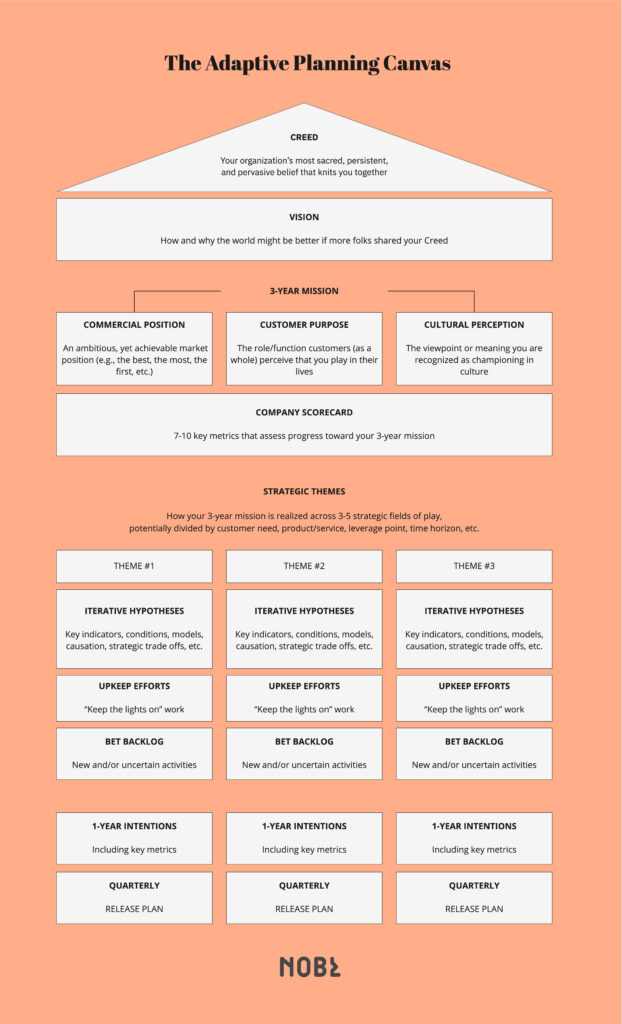Table of contents
Turn Strategic Planning into Strategic Doing
Bridge the gap between plans on paper and real-world results, and achieve the outcomes you want.
Learn MoreThere are many adjectives we could use to describe the business landscape of the last decade, some heavily overused—but one word we’d never use is “certain.” As the world has become faster, flatter, and yes, hotter, many have rightly criticized traditional strategic planning as being unresponsive to changing demands, but few alternatives have been suggested.
An Alternative to the Five-Year Plan
Starting in 2019, NOBL began leading our clients through our alternative to traditional strategic planning: Adaptive Planning. Our approach borrows heavily from the Agile software development movement (including the scaled agile framework), is inspired by Bayesian reasoning and workflows, and of course, respects many still-relevant lessons from traditional planning.
Adaptive Planning (AP for short) is grounded in a simple premise: you will be wrong. In the short term, you will be a bit wrong. In the long term, without reflection, you will be catastrophically wrong. This isn’t some personal failing, it’s simply the nature of reality today. Titans and visionaries have been wrong, and so will you. AP asks folks to plan as if they’re wrong and it encompasses a series of practices meant to ensure you are less wrong, faster.

The Basics of Adaptive Planning
Adaptive Planning is best introduced with its core values and essential practices:
- Core Values. We’ve identified four values that are essential for any team to adopt when considering long-term strategic planning, such as focusing on outcomes over outputs and learning over comfort. While the exact planning process may vary from team to team, we’ve found that first aligning on these values leads to more consistent results.
- Essential Practices. With client input, we’ve developed twelve practices that spur teams to higher levels of performance and impact, including identifying hypotheses, holding monthly roundtables, and keeping organizational bureaucracy to a minimum. When spread throughout the organization, these practices enable teams to rapidly respond even in the face of ongoing uncertainty.
In addition, we’ve also developed a “canvas” that maps out the work of Adaptive Planning, from the organization’s north star all the way down to quarterly plans. This is what ultimately replaces the five-year plan, and serves as a living, learning representation of the organization.

The Essentials of Every Strategic Planning Process
Whether you adopt our approach wholesale or not, the most important rules to remember include:
- Orienting towards outcomes, not outputs. It’s easy to track the tasks you do—emails sent, meetings held, features shipped, time spent with the client—which can feel like progress. But more often than not, those aren’t desired outcomes like “market share,” or “increased conversion.” Focusing on the actual impact you want to achieve will help you make smarter decisions about how to get there. Remember, in a complex system like the modern market, the same outcome can be reached by many paths—a concept known as equifinality. Therefore, give your teams both outcomes to reach and room to experiment with ways to get there.
- Creating “bets,” not projects. Calling initiatives “bets” might seem like semantics, but it’s more honest about their predictability and risk—how often have you seen a project with targets that are pulled from thin air or completely divorced from reality? With bets, teams feel greater license to double down or fold, depending on the actual results they see in the market. Of course, it’s also important to distinguish bets from essential operations work. Your organization must do what’s necessary and do it well if it’s going to survive, but be extremely critical about what’s truly mandatory—it’s easy for this category to expand.
- Iterating on your hypotheses. Remember, you’re going to be wrong, but that’s just a point of data, not the end. Return to and revise your assumptions based on actual data. Pro tip: it may take teams a while to truly embrace this approach, as many organizations have historically viewed delays or problems as failure.
- Reviewing and releasing plans every quarter. One of the biggest problems with traditional strategic planning processes is that they take months to develop… and then are never looked at again. Instead, make a habit of reconvening the planning team every few months to re-align your plans and balance your resources. If the strategic planning team is too big to come together all at once, work together in strategic themes.
- Budgeting incrementally. Just like project goals, budgets are all too often determined by guessing—and the more experimental or long-term a bet is, the less likely that you’ll make an accurate guess. Instead, approach budgeting like a VC with funding gates: commit to a smaller initial spend, and increase spend only if and when the team is able to prove an outcome.
- Hosting regular learning roundtables. Once a quarter, bring teams working on bets together to share what they’ve learned, where they got stuck, and what they accomplished. This is also a good time to get the collective wisdom of the group to triage any bets that are struggling.
Incorporating Adaptive Planning into an Existing Strategic Planning Process
What you have to do and the way you have to do it is incredibly simple. Whether you are willing to do it is another matter. – Peter Drucker
Adaptive Planning asks teams to collaborate, requires agile learning environments, and demands at least some appetite for risk—a significant departure from traditional (if ineffective) methods of strategic planning that result in 100-slide decks and a set of 10-year milestones and goals.
For some organizations, this may be too dramatic a shift for one year. The good news is that you can still start to apply aspects of Adaptive Planning, and shake up old ways of thinking and doing. Rather than diving in with both feet, consider biting off smaller pieces as you get started:
- Start at the team level. Maybe your multi-year strategy is already set for the organization. If so, great—you’re off to a good start! But are departments prepared to implement it? Align teams around one-year intentions, and create a quarter-by-quarter plan for how they’ll get there. Just keep in mind that in order for this process to be truly adaptive, you need to leave time and space for learning and reflection at the end of each quarter, and to iterate your ongoing approach accordingly.
- Add on. Supplement, rather than completely substitute, the long-term planning required by your board or other stakeholders. Where your existing org strategy may stop at the level of multi-year goals and KPIs, Adaptive Planning can help break down those big-picture ambitions into tangible quarter-by-quarter action plans. Get your organization out of the five-year plan, and into the realities of the near term.
- Introduce a few practices in your existing ways of working. That way, when you do adopt the new approach, the behaviors will feel less foreign. For instance:
- Instead of projects, talk about and document the “bets” you’re testing. What do you hope to gain by pursuing a bet? What do you hope to learn? This framing gets your team in the mindset that every initiative is in some way an experiment, and that they can continuously improve their approach as more information emerges.
- Implement “Learning Roundtables.” Every quarter, invite the team together to discuss data, learnings, failures, and successes. Creating these moments of coming together, reflecting, and iterating is central to the adaptive approach.
- Create a regular practice around “Sensing.” Often, leaders focus their strategies on the factors within their zone of control or influence—but we often need to be responsive to factors and forces completely outside of our control. Keep a pulse on what’s happening in your environment, and evaluate how changing conditions will impact your strategy.
- Consider what conditions would be required to adopt a new strategic planning approach. It’s likely you’ll need to work on building buy-in for the approach at the board or shareholder level. If you’ve got a risk-averse culture, prone to perfectionist tendencies, you may need to chip away at those behaviors slowly, and work on building a culture of trust and experimentation. As a leader, that means giving people permission to skateboard new ideas, and occasionally fail.
- If you’re still unsure where to begin, consider scheduling a meeting with senior leaders in your organization to conduct a retrospective on your usual strategic planning process. How much did you get right? What could you have better planned? What came as a complete surprise, and derailed your team’s efforts? Agreeing on needed improvements will help build the case for trying out a new approach for the next strategic planning cycle.
Adaptive Planning Generates Real Impact
Teams have found that while adopting a new rhythm and mindset like Adaptive Planning can feel challenging initially, they soon discover that:
- People in the organization at large love hearing about what is going on—even just reviewing a list of projects makes people feel more in touch with the organization’s progress. Not only that, listing all the projects underway may uncover multiple teams trying to solve the same problem.
- Defining measures and performance targets for outcomes is extremely difficult—but it makes teams truly assess desired outcomes and makes them more accurate, and clients have shared that their people are becoming more strategic.
- Finally, organizations are terrible at killing their darlings. They will do everything in their power to not have to prioritize, because everyone (especially in teams of high-performers) wants to do everything. This approach forces teams to focus their efforts.
Contact us to learn more about Adaptive Planning in your organization.













